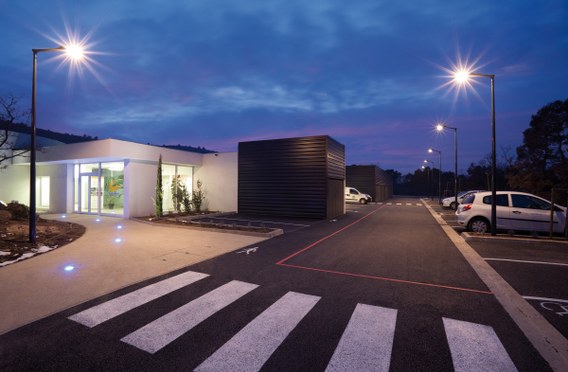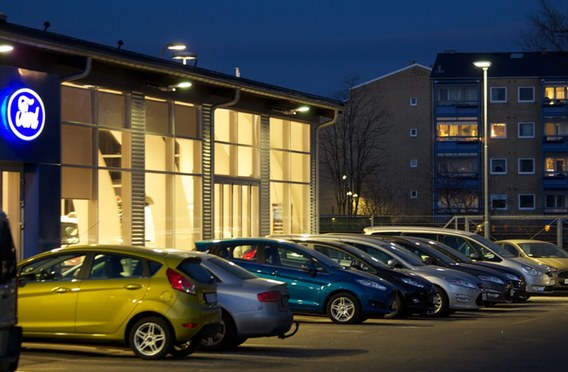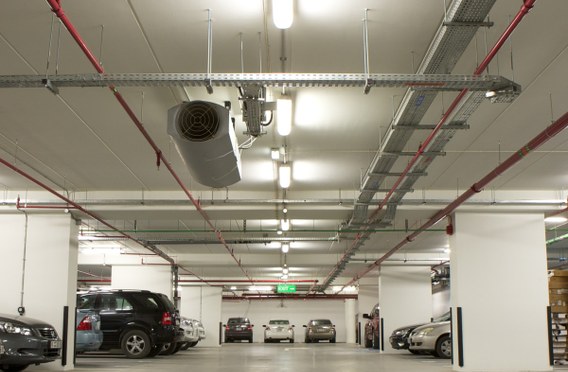Transit Areas & Car Parks
Creating the right environment
Lighting for transit areas and car parks needs to address two main concerns
- Actual safety – the requirements for pedestrians and motorised transport to move around safely. This requires careful consideration as the motorised transport may vary in size from a motorcycle to an articulated lorry with a trailer
- Perceived safety – how safe people feel moving about the space. This is not always linked to actual safety but to the ambience of the area, the difference between "Am I safe?" and "Do I feel safe?"
Other concerns can differ between types of car park, for example
- Internal or external – light surfaces for an indoor car-park will help create a more pleasant ambience compared to an outdoor car-park. However lighting should be situated to highlight access ramps for upper and lower levels and structural elements, for example columns and beams. A large outdoor car-park will require lighting columns which will need careful positioning to reduce the risk of impact for motor vehicles. Internal car-parks require careful consideration of entry and exit points to reduce the risk of collision with pedestrians. In addition for all car-parks the exit where motor vehicles may be stationary whilst waiting to join a traffic route requires special consideration to reassure as this position can have an increased crime risk.
- Free or pay – A car-park that requires payment before exit has additional key points. There is increased vulnerability to crime at pay machines where people have to use money or credit-cards and at exit barriers where the vehicle has to stop and be opened, even if only a window, to insert a ticket or key in an access code to raise an exit barrier.
In Europe lighting requirements for transit areas and car-parks are given in the documents EN 12464-1 Lighting for indoor workplaces and EN 12464-2 Lighting for outdoor workplaces.
Best practice
For exterior car-parks and transit areas lighting is generally from columns. These should be situated to prevent as little risk to motor vehicles as possible. A larger number of lower power lighting points should be used in preference to fewer higher output luminaires, especially in areas with larger vehicles such as buses or lorries, to reduce deep shadowing from parked vehicles. The lighting should help define the geometry of the space and give guidance, highlighting entrance and exit points and area boundaries. The lighting should give special consideration to facilities such as family or disabled parking areas where less mobile or less predictable pedestrian traffic may occur.
For interior car-parks lighting is mainly from the ceiling or wall. Indoor car-parks are generally more compressed and busy so lighting should give clear guidance on the layout, especially the location of ramps, pedestrian access points for the floor and pay points. Care should be taken in the use of wall-mounted fixtures to ensure visibility is not compromised by parked vehicles during busy times. Some light should be directed onto walls and ceiling to prevent a feeling of gloom, reducing the perception of safety. Emergency lighting and signage should be used to give guidance in the event of mains power failure.
Taking control
The use of photocell controls to react to levels of daylight in both exterior and interior car-parks and transit areas can ensure the correct light level at the required time using minimum electrical power. Dimming of lighting at hours of low usage can also significantly reduce energy usage, for example via the bi-power dimming facility available in many Thorn outdoor lanterns.
In outdoor facilities and areas it is important to control obtrusive light, preventing light from going into adjacent areas or upwards into the sky. The use of asymmetric luminaires that remove the need to tilt the luminaire, or luminaires with tight optical control, can maximise the amount of useful light produced by a luminaire.
The use of light sources with a long-life and high efficacy will help minimise maintenance overhead whilst also reducing the electrical power required to achieve the required lighting levels.



